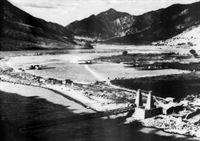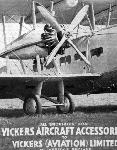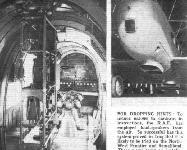
Варианты
- Vickers - Victoria - 1922 - Великобритания
- Vickers - Vanguard / Type 62 / Type 103 - 1923 - Великобритания
- Vickers - Valentia - 1934 - Великобритания
Valentia
Военно-транспортный самолет. Двухмоторный биплан смешанной конструкции. Хвостовое оперение двухкилевое бипланное. Шасси неубирающееся, оригинальной схемы (пятиточечное). Являлся развитием конструкции транспортного самолета "Виктория" VI с новой мотоустановкой. "Виктория" первоначально создавалась как бомбардировщик, но позднее из-за низких летных данных была превращена в транспортную машину. Опытный образец "Виктории" совершил первый полет 22 августа 1922 г. "Валентию" разработал в КБ фирмы "Виккерс авиэйшн" коллектив во главе с Р. Пирсоном. Опытный самолет "тип 264", ставший ее прототипом, вышел на испытания в мае 1934 г. В том же году начали переделывать по его образцу старые самолеты "Виктория" VI. Модернизация их осуществлялась как в мастерских ВВС в самой Англии (переделано 15 экз.), так и в мастерских в Хинаиди в Индии (сделали 54 экз.). Кроме того, завод "Виккерс" в Уэйбридже изготовил 28 новых "валентий". У переделок сохранялся хвостовой костыль "Виктории", у машин заводской постройки вместо него монтировалось хвостовое колесо.
Экипаж - 2 чел., 22 пассажира. Моторы "Пегасус" IIL3 (на самолетах для Индии - "Пегасус" IIM3). Штатного вооружения нет, но в сентябре 1935 г. часть машин оснастили пулеметами (2x7,9) и наружной подвеской бомб (до 1000 кг).
"Валентия" состояла на вооружении британских (с 1934 г.), южноафриканских (с 1939 г.) и индийских (с 1940 г.) ВВС. С конца 1934 г. самолеты типа "Валентия" осуществляли пассажирские и грузовые перевозки на Ближнем Востоке, а затем и в других британских колониях. В нескольких случаях они перебрасывали подкрепления гарнизонам, подвергавшимся нападениям повстанцев, в частности, на западной границе Индии. В самой Англии "валентий" использовали как учебные машины. Во время Мюнхенского кризиса самолеты, сосредоточенные в Египте, подготовили к ночным налетам на цели в Ливии. Летом 1940 г. их как раз и использовали для бомбометания по итальянским войскам в Западной пустыне. В том же году самолеты, изъятые из учебных подразделений и авиашкол, недолго патрулировали побережье Англии.
В 1941-1942 гг. "валентий" также перевозили людей и грузы на Ближнем Востоке. В мае 1941 г. они перебросили подкрепления для усиления обороны авиабазы Хаббания в Ираке, окруженной мятежными войсками Рашида Али.
Южноафриканские самолеты доставляли людей и грузы к фронту во время кампании в Эфиопии и Сомали (июнь 1940 г. - ноябрь 1941 г.). Позднее их использовали для перевозок в тылу. Индийские машины эксплуатировались в северо-восточных районах страны.
Выпуск "валентий" прекратили в мае 1936 г. Большинство машин этого типа списали в 1943 г., последнюю англичане продали Индии в июле 1944 г.
"Валентия" I||
Размах:||26,6 м
Длина:||18,14 м
Моторы, количество х мощность:||2x650 л.с.
Взлетная масса, максимальная:||8860 кг
Максимальная скорость:||193 км/ч
Практический потолок:||4955 м
Дальность:||1290 км
Описание:
- Valentia
- Vickers Type 56 Victoria, Type 264 Valentia и Type 72 Vanguard
Фотографии
-
Мировая Авиация 248
Регистрационный номер: K3611 Valentia был создан на базе самолета Victoria и оснащен парой ПД Bristol Pegasus. Машина на снимке принадлежала 216-й эскадрилье британских ВВС, эксплуатировавшей эти машины в 1935-1941 годах.
-
Flight 1935-08 / Flight
The Vickers "Valentia" is an improved "Victoria" with "low duty" "Pegasus" engines. The performance is considerably improved.
-
Моделист-Конструктор Военно-транспортные самолеты Второй мировой войны
"Валентия" из 50-й эскадрильи южноафриканских ВВС на передовом аэродроме в Восточной Африке, 1941 г.
-
Aeroplane Monthly 1979-04 / Personal album
South African Air Force Vickers Valentia troop carrier 265 was photographed in May 1942. This was one of seven ex-RAF Valentias serialled 264 to 270, and 633 was another of these primitive inter-war military transports. Basically Victorias with 635 h.p. Bristol Pegasus IIM3 radial engines in place of the Napier Lions, 28 Valentias were built, and 54 Victorias were converted to Valentia standard. The tailwheel that distinguished the Valentia from the Victoria Mk VI is clearly visible here.
-
Aeroplane Monthly 1976-03 / H.Levy - Middle East exiles
An anonymous Vickers Valentia troop carrier at Heliopolis, Egypt in 1943. The Valentia was developed from the Victoria, and could accommodate 22 troops.
Vickers Valentia troop carriers carried on in the Middle East well into the war. This one is seen at Heliopolis, Egypt, in 1943. -
Flight 1936-02 / Flight
THE BAGGAGE TRAIN Two Vickers Valentias carried the equipment of this Hart squadron on its flight from Risalpur to Singapore and back. Here they are seen at Dum Dura, near Calcutta.
-
Aeroplane Monthly 1990-03 / W.Smith - The Flying Shuftis
An impressive line-up of 208 Squadron Audaxes, Fairey Gordons and Vickers Valentias at RAF Heliopolis in early 1939. Atlases had been phased out of service with 208 Squadron by the end of 1935, superseded by the Audax.
Другие самолёты на фотографии: Fairey Gordon / Seal - Великобритания - 1931Hawker Audax - Великобритания - 1931
-
Air-Britain Aeromilitaria 1980-03
R.A.F. bomber squadrons are stationed abroad. Here is a striking “pose” by the machines and personnel of the R.A.F. station at Heliopolis. This picture was taken last year, before re-equipment.
Другие самолёты на фотографии: Fairey Gordon / Seal - Великобритания - 1931Hawker Audax - Великобритания - 1931
-
Air-Britain Aeromilitaria 1982-03
Valentias of No.216 Squadron
-
Air Pictorial 1955-11 / B.Robertson - British military serials - their origin and history (1)
Регистрационный номер: K2340 Regulation size for serial markings on the undersides of bomber-transports from 1926-39 was 4 ft. digits. This is a Vickers Valentia (converted from a Victoria Mk. V) of the B.T. Flight of No. 31 (A.C.) Squadron in 1939.
-
Мировая Авиация 79
Командование британских ВВС на Ближнем Востоке было вынуждено оборонять огромное пространство, располагая преимущественно устаревшими самолетами. Одним из них был и Vickers Valentia, запечатленный здесь над Гелиополисом, недалеко от Каира (Египет).
-
Flight 1938-05 / Flight
Vickers Valentia bomber-transports (two Pegasus) over Cairo. Though of somewhat antiquated type, the Valentia is still doing yeoman service out East.
-
Flight 1936-08 / Flight
Keepers of the Pax Britannica: Vickers Valentias over the citadel of Cairo.
-
Flight 1936-06 / Flight
CONVOY: A flight of Vickers Valentia bomber-transports (Pegasus) conveying urgent supplies of machine guns ammunition and stores during the Palestine troubles. By train the 300-mile journey takes fourteen hours. The Valentias do it in three.
-
Flight 1937-06 / Flight
Deserts are quite a usual feature of overseas air work. Here Vickers Valentia transports are seen carrying supplies from Egypt to Palestine.
-
Air Enthusiast 1998-03 / Round-Out
A classic RAF portrait, Vickers Valentias of 216 Squadron over the Pyramids.
-
Flight 1936-01 / Flight
PANORAMA OF THE PYRAMIDS. Many aerial photographs of the Pyramids have been taken and published, but there is novelty in the extensive view shown in this picture, taken from one of the bomber-transport machines of No. 216 (B.T.) Squadron, which is stationed at Heliopolis. The whole array of Pyramids is seen, while the arrow points out the location of the Sphinx. The recent excavations round the base of that mysterious monument can be discerned. The considerable town in the neighbourhood is also interesting.
-
Aeroplane Monthly 1984-05 / Personal album
A 520lb bomb on its way from a Vickers Valentia of B. T. Flight, Lahore, to flatten a village inhabited by troublesome tribes. The villagers had been forewarned of the attack, by airdropped leaflets. Such raids as this would, it was hoped, bring warring tribes together to fight the common enemy - the RAF!
-
Aeroplane Monthly 1983-06 / T.Dudgeon - The roof of the world
Vickers Valentias of 31 (BT) Sqn from Lahore at Drosh, photographed from the edge of the landing ground. Note the cloud of dust behind the middle aircraft as it trundles in. Valentias accommodated 22 troops and a crew of two and although used primarily as troop-carriers they could be fitted with bomb racks to carry’ a total bomb load of 2,200lb.
-
Flight 1936-10 / Flight
"DONA FERENS": Sir Philip Sassoon, who is making a tour of Air Force stations overseas, inspecting No. 216 (Bomber Transport) Squadron at Heliopolis. The officers and men are drawn up in front of their Valentias and the squadron badge of an eagle holding a bomb can be seen on the nearest machine.
-
Flight 1938-10 / Flight
ON THE NORTH-WEST FRONTIER: Once every two years the garrison of Chitral is relieved. Owing to the mountainous nature of the route, and the height of the pass (10,500ft.) it takes more than three days for the column to reach Chitral. This year, part of the forces concerned were flown up to a landing ground near Chitral, the journey taking less than one hour. Some of the relieving garrison - Sikh Sepoys - are seen entering a Vickers Valentia of the Bomber-Transport Flight at Risalpur.
-
Flight 1934-11 / Flight
The "Valentia" (two "Pegasus") Troop-carrier;
-
Aeroplane Monthly 1984-05 / Personal album
Left, a Valentia at RAF Ambala being bombed up with 20lb and 520lb bombs by Cpl Bailey. The smaller bombs were used as sighters. Middle, a Valentia bombed up and ready for operations. Note the 8 1/2 lb practice bombs and the graffiti. Note too that the tarmac is bricked - RAF Risalpur in 1938. Right, a Valentia at RAF Lahore in 1938 with a spare engine stowed, en route to another squadron.
-
Flight 1935-12 / Flight
FOR DROPPING HINTS: To induce natives to conform to instructions, the R.A.F. has employed loud-speakers from the air. So successful has this system proved in Iraq that it is likely to be tried on the North-West Frontier and Somaliland. These views show an installation in a Vickers Valentia.
- Фотографии



























